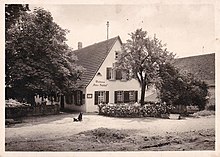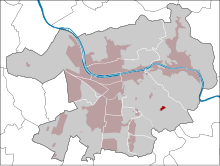Old Kohlhof
The Alte Kohlhof is a former agricultural yard and the oldest part of a collection of 10 properties of the Kohlhof southeast of the Königstuhl in the city forest of Heidelberg . The listed courtyard is one of the most famous buildings in Heidelberg and is part of the regional culture of memory. Numerous historical records, newspaper reports and postcards attest to its importance within the city of Heidelberg. The building has also been used as a restaurant since the 19th century.
location
The Alte Kohlhof is located in the Bergstrasse Mitte landscape protection area and is part of the outdoor area under building law in accordance with Section 35 of the Building Code . In the depression of the Alter Kohlhof and its surroundings, numerous springs arise that flow down to the Elsenz valley , including the Michaelsbrunnen and the Busenbrunnen . The old Kohlhof borders on the largest orchard in Heidelberg.
history
With the approval of Eberhard Friedrich von Venningen, chief hunter of the Electorate of the Palatinate, and the city of Heidelberg, the clearing of the municipal Allmendwald on the site of today's Kohlhof began in 1706 in order to create fields. The courtyard built by the city on this site and given to tenants was initially called the Busenbronner Hof because of the well that rises there . The current name Alter Kohlhof did not establish itself until the beginning of the 20th century and probably testifies to the charcoal burning in the nearby Kohlwald , especially on the Großer Kohlplatt .
The property of the Alten Kohlhof is the oldest settlement in the entire Kohlhof. Before 1854 the school of the scattered settlement was also located there . The lintel of the former yard from the 18th century has been preserved and bears the date 1756. Around 1840 the building was redesigned after a fire. The property also has a barn (dating from the lintel in 1798). The property has been used as an inn since the 19th century and received its common name Alter Kohlhof after the construction of the Kohlhof spa hotel .
In the 19th century, at the same time as farmers left the Kohlhof and its structural change, the rediscovery of Heidelberg Castle by the Romantics and, with the construction of the observation tower on the Königstuhl in 1832, the plateau south-east of Heidelberg was used for tourism. As early as the 1830s, the then innkeeper of the Kohlhof tried to attract guests from Heidelberg.
The historic main building made of red sandstone was torn down by the city of Heidelberg in 1953, replaced by an enlarged new building and supplemented by a right-angled extension. Only the sandstone barn located to the south was excluded from the construction work, the historical building fabric was only preserved in the base area. A historic tiled stove was damaged in a storm during the renovation in 1954 and then restored in a modified form. The property has not been used for agriculture since it was rebuilt as a guest house in 1954. Today the orchards are grazed with goats to maintain the landscape.
The beautiful location of the Kohlhof allowed other gastronomic businesses to emerge after 1960 in addition to the restaurant with the Hotel Alter Kohlhof . In the 1970s, the neighboring Café Ehmann was a popular eatery.
The last lease of the Alten Kohlhof ended in 1991 and the property stood empty for a long time. After an unsuccessful search for a gastronomic tenant, the city of Heidelberg sold the Alten Kohlhof in 1997 to a part-time winemaker from Rauenberg who wanted to resume the former gastronomic use. In the course of the sale, the entire property was placed under monument protection. The guest house with shared bathroom and toilets was converted into 12 modern hotel rooms. In addition, a conference room and an adjoining room for celebrations were created. The seating capacity increased from almost 100 to 170 seats. In 2014 the operators had to file for bankruptcy and in 2015 the property was sold again.
The restaurant upstairs has been in operation in the buildings of the Alten Kohlhof since the beginning of 2017 . Chef de cuisine is Robert Rädel , who has already earned a Michelin star in the Lingental estate and was also awarded a star in the Kohlhof in 2019. The inn upstairs has been refurbished with a decidedly rustic interior.
literature
- Georg Stein (Hrsg.): The island in the forest - 300 years Heidelberg Kohlhof . Palmyra Verlag, Heidelberg 2006, ISBN 3-930378-71-X .
- Claudia Baer-Schneider: "Posselts-Lust". Lookout tower in the Heidelberg city forest. In: Denkmalpflege in Baden-Württemberg , Volume 40, Issue 3, 2011, pp. 174–175, ( PDF; 5.2 MB ).
Web links
- restaurant-oben.de - Restaurant in the old Kohlhof
Individual evidence
- ↑ Rs: repurchase Alter Kohlhof: CDU supports Rückkabwicklung the city of Heidelberg. In: die-stadtredaktion.de , January 22, 2017.
- ↑ Sebastian Riemer: Alter Kohlhof Heidelberg: Exclusive restaurant opens on Sunday. In: Rhein-Neckar-Zeitung . January 10, 2017, accessed December 10, 2018 .
- ↑ Inge Höltzcke (hö): Three stars for Heidelberg. For the first time, the "top" is in the restaurant guide "Michelin". In: Rhein-Neckar-Zeitung , February 27, 2019.
- ↑ Barbara Supp : Unwanted star chef in Heidelberg. “Our philosophy: make something fine out of neglected body parts.” In: Der Spiegel , November 5, 2019, only the beginning of the article free.
Coordinates: 49 ° 23 ′ 13.5 ″ N , 8 ° 44 ′ 9 ″ E



